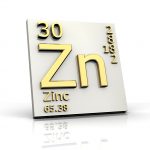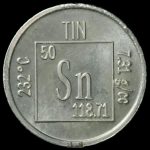Terne Coated Stainless

 There is a great deal of hard science in the art of roofing and cladding. We tend to focus more on the engineering of the roofing itself, but we’ve been asked a lot about our terne material and wish to clarify a few more points about certain chemical properties of zinc and tin in particular.
There is a great deal of hard science in the art of roofing and cladding. We tend to focus more on the engineering of the roofing itself, but we’ve been asked a lot about our terne material and wish to clarify a few more points about certain chemical properties of zinc and tin in particular.
When you think about terne in the U.S., you think about a zinc/tin alloy. Though terne has been in vogue since the Colonial Era, the tin/zinc we know today came in to popularity as tin/lead mixes and cadmium (a zinc by-product discovered in the early 19th century which shares many similarities to zinc) were proven to be extremely toxic and generally avoided in architecture and otherwise from the 1960s on.
Tin/Zinc is generally considered almost twice as effective as cadmium plating and is up to five times better at corrosion protection than traditional zinc plating. Tin/zinc alloy (sometimes called ZT) can be applied to copper, tin, bronze, steel and even titanium. We tend to see it mostly on stainless steel. 
Architectural stainless steels are not all created equal. Many companies have developed and added certain ingredients into their proprietary mixes (jealously guarded “recipes”) which aid their stainless steels in overcoming corrosion better than their competitors. (This is saying something because even “low-grade” stainless steel can last virtually forever…but yes, lower grade stainless can rust contrary to popular belief.)
The Persian Gulf for example, is an area of the world where a perfect storm of natural factors combine to create a particularly corrosive environment which especially benefits from special, high-grade, stainless steel concoctions. These ensure material stability and eternal finish perfection without the need for coatings/alloy bonds.
But before we go on, let’s talk about zinc: Zinc has been used historically in the making of alloys (brass being a major one) long before the metal itself was even identified. Swiss alchemist Theophrastus Bombastus von Hohenheim (wow, that’s a name!) finally gave zinc its name at the beginning of the 16th century.
Globally, the largest use of zinc goes in to the process of galvanizing. Galvanizing as you know, refers to the cathodic protection zinc offers to iron. (Zinc is used a “sacrificial” topcoat to protect the steel component underneath from corroding.) Though French engineer, Stanislas Sorel patented this process in 1837, there is evidence of primitive use of this method dating back as early as 1740.
 It was English scientist, Michael Faraday who, in 1829, first noted the phenomenon of cathodic protection. Zinc, unlike tin (which we’ll talk about next), is higher in the electromotive series than iron. (See chart at the end of this article.) Zinc will sacrifice itself to protect the iron, reducing it to the metal and eliminating rust. (Galvanized steel lasts in relation to the thickness of the zinc coating.) Galvanized iron can continue to provide protection against rust, even when small holes develop in the zinc coating, because the zinc will be oxidized in preference to iron.
It was English scientist, Michael Faraday who, in 1829, first noted the phenomenon of cathodic protection. Zinc, unlike tin (which we’ll talk about next), is higher in the electromotive series than iron. (See chart at the end of this article.) Zinc will sacrifice itself to protect the iron, reducing it to the metal and eliminating rust. (Galvanized steel lasts in relation to the thickness of the zinc coating.) Galvanized iron can continue to provide protection against rust, even when small holes develop in the zinc coating, because the zinc will be oxidized in preference to iron.
It is because of this reactive, protective property zinc has been able to weather-proof our lives, and we’re all grateful for it. However, zinc’s giving nature is ultimately its downfall.
As a comparison, copper builds upon itself with any foreign items which come in to contact with it. During our historical restoration work back in Europe on copper-clad buildings over 600 years old, we have personally seen cross sections of this material which has quadrupled its original thickness. Obviously this remarkable feature enables buildings clad with copper to be strengthened as time goes by. Quite incredible!
Zinc develops a patina as well, but unlike copper which builds on to itself, zinc as we have learned, builds FROM itself. Over time it gets thinner and weaker.
 Zinc is a terrific fine metal choice for architectural cladding. We use it and highly recommend it on a daily basis. It’s beautiful and absolutely has its place. But due to its self-sacrificing nature, it doesn’t come close to the permanence of tin or stainless steel. Certainly lasting heaps longer than most other contemporary roofing options, zinc will still have to be replaced every hundred years or so—even if it is installed with perfection. When compared to the lasting power of tin and stainless steel, this is the blink of an eye.
Zinc is a terrific fine metal choice for architectural cladding. We use it and highly recommend it on a daily basis. It’s beautiful and absolutely has its place. But due to its self-sacrificing nature, it doesn’t come close to the permanence of tin or stainless steel. Certainly lasting heaps longer than most other contemporary roofing options, zinc will still have to be replaced every hundred years or so—even if it is installed with perfection. When compared to the lasting power of tin and stainless steel, this is the blink of an eye.
Too soft to use for architectural purposes on its own, tin is historically another metal frequently used for coating other metals as it possesses rock star corrosion prevention properties in its own right.
 When you think of tin, generally the first thought is of a can. Before much more cost-effective aluminum came along, tin is what was generally used—because it was malleable and worked great! While we’re on the subject, have you ever really thought about why you can’t use galvanized steel for canning? The zinc coating on the steel is attacked by food acids and within a short time, the can would corrode and the food would fall out. Evidently not very effective.
When you think of tin, generally the first thought is of a can. Before much more cost-effective aluminum came along, tin is what was generally used—because it was malleable and worked great! While we’re on the subject, have you ever really thought about why you can’t use galvanized steel for canning? The zinc coating on the steel is attacked by food acids and within a short time, the can would corrode and the food would fall out. Evidently not very effective.
Tin is generally non-reactive, possesses no known toxicity to life on Earth and is completely immune to this kind of attack. Whereas in modern times, galvanizing is generally a hot dip process, tin tends to be applied electrolytically which also aids in consistent distribution.
Tin is much more costly than zinc. That’s a fact. Because of this, you’ll often see very thin coats of tin or mixes of other metals in with the tin to cut down on cost.
If the stainless steel is of good quality and a thick layer of tin covers the entire surface, why would you need the addition of zinc? We can’t think of a reason, either.
If steel and tin are meant to last for potentially thousands of years, why use a metal that might not last a century? Devoid of sense and ethics.
Is zinc as solderable as tin? Nope.
When, all things being equal, pure tin and zinc/tin alloy weather to a similar finish, and quality stainless is covered in corrosion-resistant tin, why in the world do you even need zinc in this case? You don’t.
Is this a persnickety, punctilious argument? Maybe. But we preach permanence.
Just as the castles of old draw today’s crowds to marvel at the architecture, so should we continue in the architectural legacy of our time—but better. Because we have better and we know better.

